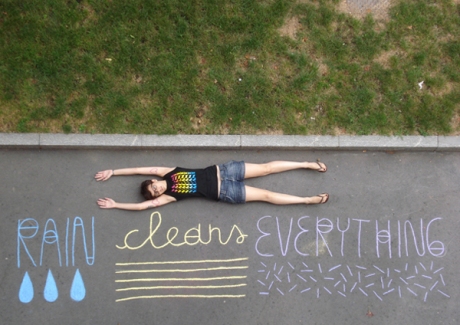Readings 15 + 16
December 8, 2009

How do you handle a frustrating creative process? How do you handle potentially negative press about your work? How do you keep working as hard as you can and as good as you can? Ask Will Bryant. I think he’s on to something.
+ + + + + + + +
How to be a graphic designer without losing your soul by Adrian Shaughnessy
Chapters 8 + 9
Self-Promotion + The Creative Process
+ + + + + + + +
Christy and I decided to googlechat instead of writing a reading response because we had both waited until the last minute to finish them all and we were sick of writing reading responses. Well, that’s at least my outlook on the whole thing. Below are some excerpts of our conversation, interspersed with my own thoughts and some found images that are supposedly relevant to our conversation.
Self-promotional piece from Cari Vanderyacht, PSU alum. Whoops! I guess it worked! She works at W+K now!
Christy: ‘I don’t want to be famous, I just want my peers to like what I do.’ lol
me: oh hey
one second
Christy: cool 🙂
me: but that’s what I define “famous” as!
Christy: I know, that’s sort what was funny about that because that’s what we all strive for.
the acceptance from our peers
me: Agreed. I want people to want to put my work up on their walls as inspiration!
Christy: me too, I’m not there yet but hopefully soon …
Admiration + respect, not fame
me: yessss
 Promotional design by Kyle Van Horn. Pretty smart.
Promotional design by Kyle Van Horn. Pretty smart.
me: There was an interesting note about fame in terms of getting press.
Want to hear a quote I typed?
Christy: yes
me: Oops, no quote. Just a paraphrase: One piece of design press (one article, one blog post) doesn’t equal instant fame, it’s accumulative. People have to read about you + see your work a few times in order to recognize that you’re capable of greatness.
Christy: lol
me: That one made me humble =)
Christy: Self promotion is the ability to make it in people’s minds, mouths and walls … in addition to our doings when we give people our cards and promo pieces. Blogs help get others to see what we can do.
me: Yeah, blogs are really interesting in that regard. They are real enough to make us feel like attaining acceptance onto them is the ULTIMATE, but they’re super ephemeral.
There were no blogs around when Charles and Ray were making things together. I have a sneaking suspicion that they didn’t give a shit about being famous. They just wanted to make good stuff. Let’s all learn from the Eamses!
Christy: the reputation such fame brings or the reputation one strives for
as you make the press will come to you
me: I want my reputation to be that I’m a forest creature that lives in a tree house! (=totally false)
Christy: I want my reputation to begin, but at the same time I don’t even care. I just love working with other people and getting out there in any way I can. If I go throughout my whole life never being mentioned in a magazine or blog, I’ll be ok. Just as long as I am working with great people like Nicole, Precious and many others 🙂
me: Oh, you! If you have your mind set on making making making and challenging yourself and putting your work out there, you’ll totally make it happen.
People will notice, whether you are trying to get them to or not!

Some advice on how to approach the idea of getting written about on blogs or not getting written about on blogs. I wish I could say, “Jeez, they’re just BLOGS, get over it!” But ask any one of my roommates how much I freak out when I get a google alert with my name in it…
Christy: I agree with that. lol, I’m trying to go through this chapter
me: Did you read the part about self-initiated briefs? “Graphic authorship?”
Christy: Oh, constraint, that’s interesting.
no both chapters is good
I haven’t read them fully
me: Yeah, constraint!
I really liked the concept of giving myself a brief to work with.
Like, defining my goals, touchpoints, themes for a project, making a proposal to myself, and then striving to accomplish it.
It makes me think that all artists wish they knew about design briefs!
Christy: “designers need briefs like cars need fuel”
me: oooh did you make that up?

Creative Process in Action: Jesse Brown and Chad Kouri of the Post Family camped out at Renegade Handmade in Chicago for a week and worked in the window.
Christy: Oh man, the creative process … it’s a long one sometimes
me: Whoops, sorry, was taking screen shots of my brand book.
TIME MANAGEMENT>
That is what I need.
I think that is what a brief will help with.
Christy: I sort of just want to find a design job or something in the field that pays me well enough that I can go to Holland for a holiday and come back inspired and well rounded.
me: YES.
That sounds perfect.

Sorry. I can’t stop thinking about bloggers. This lovely little thing was made by David Fullarton. SWEET.
Christy: see you tomorrow at 2!
me: yeah! nice chatting with you
Christy: you too . bye
THIS PLACE PROJECTS, FINAL STUFF (for this term)
December 8, 2009

I intended this project to be a long one. One that I could focus on long after school finishes, and certainly into the next two academic terms.
So the word “final” applied to these images and ideas is somewhat of a false one. In the realm of Art 470, Fall Term 2009 with Lis Charman, these are final images and ideas. But in the rest of time and space This Place Projects is an ever-evolving project.
Download a PDF of my brand book here: BRANDBOOK
See close-ups below.
Thank you!
 Places that inspired the formation of This Place.
Places that inspired the formation of This Place.
 Visual Mood for the project: nostalgic, timeless, regional.
Visual Mood for the project: nostalgic, timeless, regional.
 The Hometown Lecture Series: Documentation of peoples’ lectures.
The Hometown Lecture Series: Documentation of peoples’ lectures.

TP1 > An Ode To Summer In The West by Nicole Lavelle (me!)
(See more on Flickr.)
Readings 9 + 10 + 11
December 7, 2009
Chapters 2, 3 and 4 from How to Be a Graphic Designer Without Losing Your Soul
(How to find a job + Being freelance + Setting up a studio)
Each of these chapters could have been its own book. They need more room to stretch. That’s my sole criticism.
Tips on portfolios were useful. The anecdote of the young woman trying to open her portfolio only to have turned it upside down made me cringe and laugh at the same time. Awkward!
 Even if I work at some huge soul-less firm and don’t have a workspace of my own, I want to make sure to have a fully-stocked home studio for tinkering in on the weekends (and early mornings!) (Skinny Laminx studio via sharesomecandy)
Even if I work at some huge soul-less firm and don’t have a workspace of my own, I want to make sure to have a fully-stocked home studio for tinkering in on the weekends (and early mornings!) (Skinny Laminx studio via sharesomecandy)
The prospect of the ultimate flexibility that accompanies being freelance is SO utterly appealing that I have to keep from quitting school, quitting my job, and running out into the world of graphic design to fend for myself. That said, the stability (financial and schedule) gained from a regular, full-time job is also more realistic and practical. My goal is to find a happy medium that allows me to take time off to hang out with my sisters AND that gets me up at the same time every morning. Working on freelance projects but in the company of others is the MOST appealing scenario this book has posed for my future working life. Having creative people around to bounce ideas off of PLUS having the freedom to take a nap after lunch sounds terrific.
 The ULTIMATE cabin studio of Mel Kadel and Travis Millard (Via Fecal Face.) I would work here. Happily.
The ULTIMATE cabin studio of Mel Kadel and Travis Millard (Via Fecal Face.) I would work here. Happily.
 Skinny Laminx makes working for yourself look REALLY GOOD. Teatime anyone? (Via sharesomecandy)
Skinny Laminx makes working for yourself look REALLY GOOD. Teatime anyone? (Via sharesomecandy)
I most appreciated the insight into the client-designer relationship and how it manifests in each of these three scenarios: working within an existing studio, working on your own, or setting up your own studio
The client-designer relationship is one that mystifies me. At the point we’re at, most of us design students have only worked for our parents, our family friends, our neighbors or the coffee shop down the street. The end objective for accepting such jobs is usually to boost the variety of work in our portfolio. We rarely get paid, and if we do, it’s measly. We don’t choose our clients and our clients don’t choose us: these relationships are the result of circumstance and convenience, not typical scenarios that pop up in the “real” design world.
 A place to talk to clients, in the Minneapolis studios of Eight Hour Day. (Via sharesomecandy)
A place to talk to clients, in the Minneapolis studios of Eight Hour Day. (Via sharesomecandy)
I also liked the idea of a craving for authorship as being the impetus to start one’s own studio. At least for a while, I’d like to continue having support to ease out of the school environment. But as soon as the work I’m making under the direction of others starts to feel stagnant or separate from my creative input, I’ll get my own digs. I’ll keep the notion of authorship in the back of my mind to help me pinpoint if I’m getting bored.
 Can’t stop gawking at dream workspaces. APAK studio via sharesomecandy.
Can’t stop gawking at dream workspaces. APAK studio via sharesomecandy.
Considering authorship is another way to tie these three separate (but related) design existences together (working for another studio, being freelance, setting up your own studio.) In a freelance situation, you retain sole authorship of your work, your voice is heard and your aesthetic is obviously stated. This appeals to me the most, but I also am wary of diving into a situation where my skills and work are judged so directly until I feel comfortable in my design shoes! Must find that voice, must have that commanding use of type, must be SO GOOD before I break out on my own.
 Some beautiful personal work by Lisa Congdon. (via sharesomecandy)
Some beautiful personal work by Lisa Congdon. (via sharesomecandy)
Margaret Richardson said in Art History class the other day, “Your life will start as soon as you start thinking of yourselves not as design students, but as designers.” She meant, “Do it now.” Make that mental switch and things will start to make more sense. The transition out of school won’t be so difficult.
Thanks, Margaret. Now, can you get me a job at Nike? (Just kidding.)
DID ANYONE ELSE KNOW THAT IT’S WEEK SEVEN ALREADY?
November 10, 2009
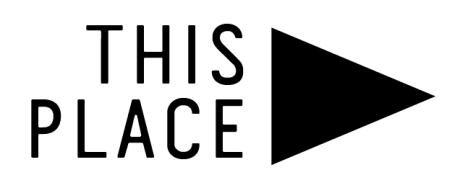
Didn’t see that coming.
Update on my progress since last class:
- Bought a URL (www.thisplaceprojects.com)
- Installed WordPress
- Am adjusting a theme to be what I want it to be.
- Inserted placeholder content on the site
- Began to think more seriously about real content for the site
- Finalized my logo!
- Developed a system of usage to ensure versatility within rigidity
- Explored three directions for the Hometown Lecture Series posters
- What next?
- Figure out CSS so my site looks nice
- Keep working with the two releases I have lined up: Sarah Baugh and Charlie Ertola.
- Develop content for the site
- Draft a press release/announcement of the site to send out.
- But first build it up so it’s SO RAD that people are into it.
Peep my visual progress over on flickr.
WORDPRESS, WOOHOO!
November 9, 2009
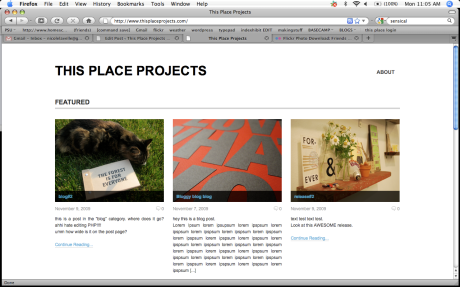
They really do make it easy for you to sync up a url to a wordpress blog. Awesome!
But not php. That is not easy.
Check it out!
http://www.thisplaceprojects.com
- It’s all placeholder content, but you can get a good idea of the format.
- Does the format feel good? Is this the right theme for me to use? Click around, try to get back to things, is the navigation acceptable?
- I will change the blue type and try to add my own header. Trying to get the posts in the right place, haven’t even started with CSS yet!
- Working on making sense of the categories, how many i really need, and where the posts go when i write them.
- Ack. If anyone is a php wizard, shoot me an email. I need you. Can trade baked goods, design work or nature walks if you want to be the web friend that I exploit for your skills. (That sounds terrible.)
THIS PLACE PROJECTS WEB CONTENT
October 29, 2009
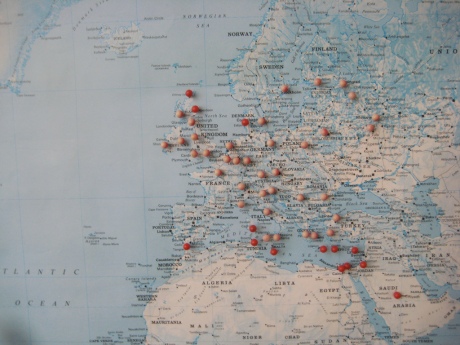
A site map: another thing that was due today.
WHAT DOES THIS PLACE PROJECTS LOOK LIKE ON THE INTERNET?
Three sections.
Frequently updated content that promotes and unites projects and facilitates discussion.
• Artists, projects, books, writers, photographers, events, organizations, record labels, imprints.
• Interviews, reviews, comparisons.
• Photographic exploration of places. (TPP exclusives) (myself, my community, artists I approach,
• News: grants, new project releases, promotional for events and releases.
• Call for entries: collaborative zine? Whole, independent projects?
• Exhibition for This Place Projects projects.
• Documentation of the project: photographed objects, photographed events.
SECTION THREE: Navigation/Information/About
• About This Place Projects
• List of This Place Projects artists and their relevant links.
• Blog bios, guest bloggers.
• Store to purchase releases
PERSONAS
October 29, 2009
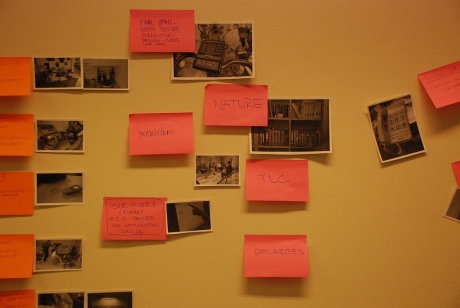 User research. Flickr.
User research. Flickr.
This is a reading response to Personas: Practice and Theory by John Pruitt and Jonathan Grudin from the book Design Studies.
“Personas are a medium for communication; a conduit for information about users and work settings derived from ethnographies, market research, usability studies, interviews, observations and so on.”
Call it what you will: user archetypes, market segmentation, user role definition, user profiling, fictional charaters: this article hails the importance of all designers and developers having a detailed understanding of human behavior. Designers often have a vague or contradictory sense of intended users, and may base scenarios on themselves. I do this all the time. I often find myself making work that I’d use and like, but this only goes so far. Developing personas can “amplify the effectiveness of other research methods.” As designers, the act of creating personas can help us make our assumptions about our target audience more explicit.
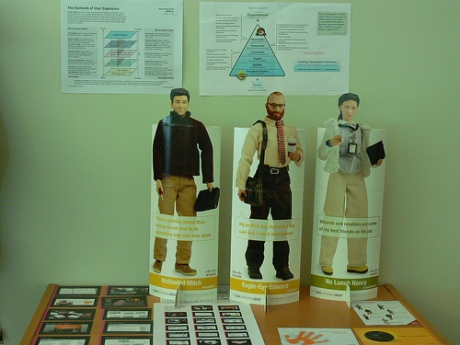 Little stand-up personas. Flickr.
Little stand-up personas. Flickr.
Though there’s nothing more boring than reading about the development of MSN Explorer, this article was valuable to me. It encouraged me to think more critically about my audience. I must be more willing to take myself out of the picture from time to time and realize that not all consumers of my design are white, 20-something middle-class hipsters from Portland, Oregon.
SAGMEISTER AND EMOTION
October 29, 2009
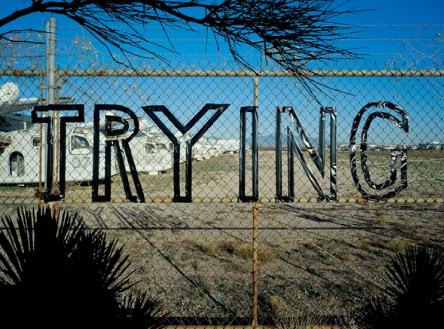

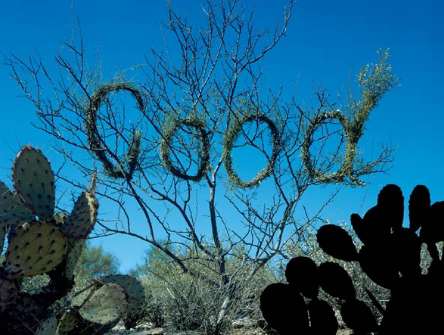
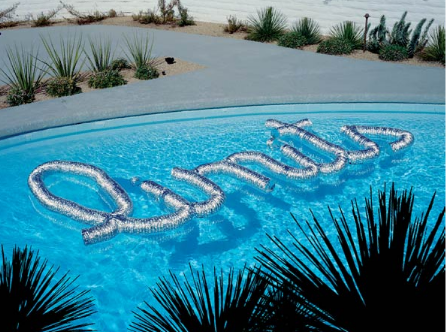
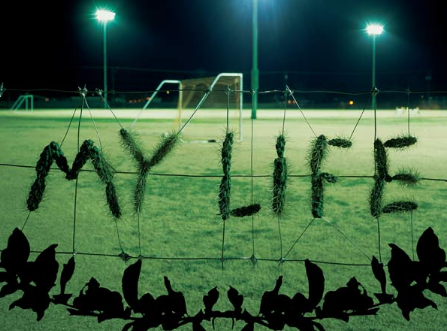 Art Grandeur Nature, 2004, Stefan Sagmeister
Art Grandeur Nature, 2004, Stefan Sagmeister
This is a reading response to Stefan Sagmeister’s essay on emotion in graphic design.
I really liked this reading. I feel that designers, or at least design students, are always after Sagmeister’s secret–how does he make the amazing work he makes? It must be his sabbaticals. It must be his apt sculptural typography skills. It must be that he’s European. Wrong. This article smashes all of that. Like any other artist or designer, he is a living, breathing human being, and his strength comes in embracing that.
The secret to success? Make yourself feel your design. Really, really feel it. Inside, not with your fingers. If you don’t feel anything, maybe rethink the project.
This of course is only a certain kind of success, but a kind that I’m hoping to find.
I tried to choose a favorite part of this essay to focus on, but I couldn’t. Each section offered something new and refreshing. I appreciated the whole thing. The best part for me was that even though he listed a number of graphic design projects that touched him, a lot of them weren’t simply design. They were hybrid projects: art, graffiti, comics. I hold fast that what makes an interesting designer is a well-rounded interest in many things. As designers, we’re the mirrors of the world, in some sense. If we’re not actively watching, listening, feeling, our work will lack meaningful content.
“So ever since I got that black canvas bag at that conference in New Orleans, this touching thing has been on my mind, and I’ve looked for design pieces that cut through to my heart.”
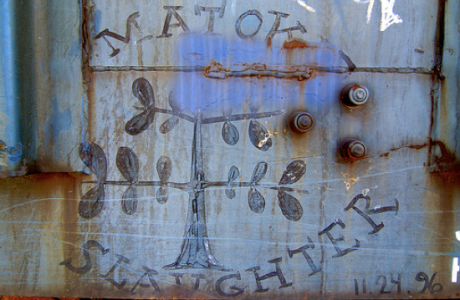 I feel more when I look at this than when I look at most other things. Matokie Slaughter.
I feel more when I look at this than when I look at most other things. Matokie Slaughter.
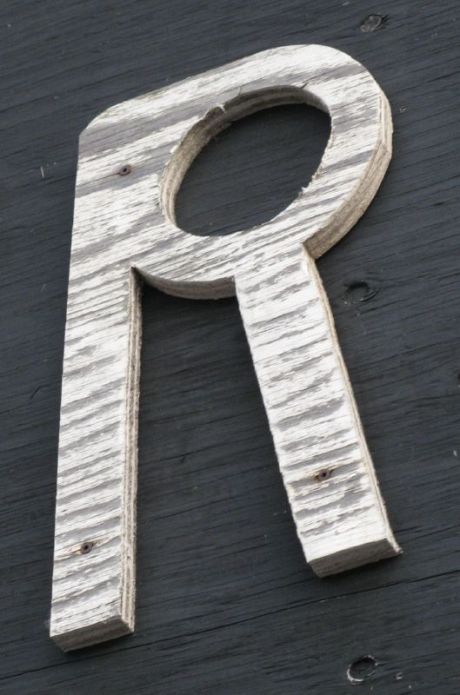 This moves me. More.
This moves me. More.
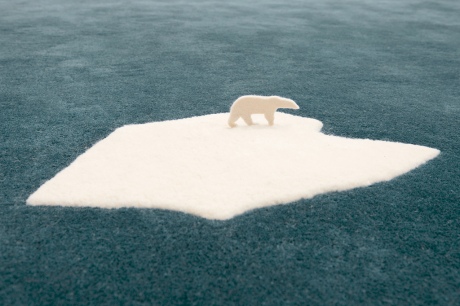 So does this. A global warming rug.
So does this. A global warming rug.
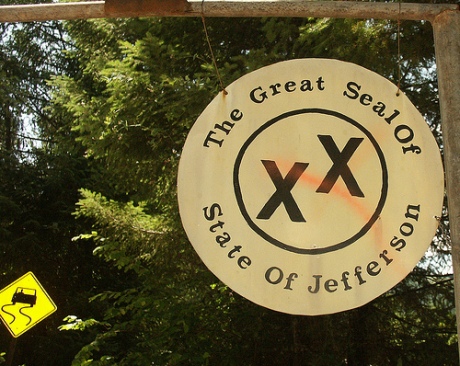 And this: a homemade state seal for a rural secessionist movement. Two x’s=double crossed.
And this: a homemade state seal for a rural secessionist movement. Two x’s=double crossed.
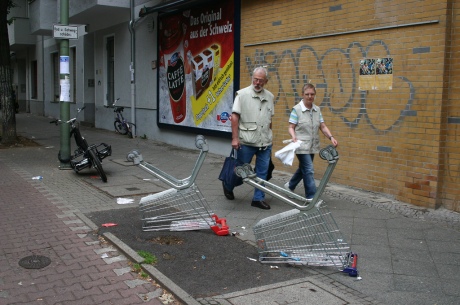 And this. Elizabeth Jaeger took this in Berlin. Two bicycles at the same angle, two shopping carts at the same angle, two people wearing the exact same thing, two posters, there’s probably more.
And this. Elizabeth Jaeger took this in Berlin. Two bicycles at the same angle, two shopping carts at the same angle, two people wearing the exact same thing, two posters, there’s probably more.
“I suspect that in ten years time this touching kind of design is going to be the only kind of design that’s going to be done by actual designers.”
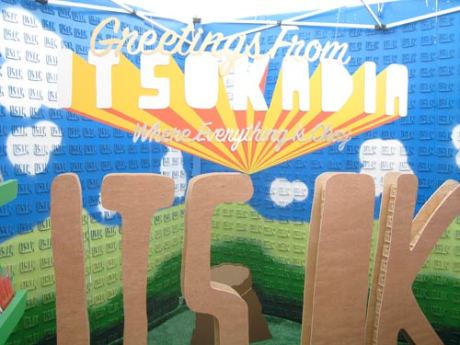 Then there’s this kind of stuff. Hyper-meaningful graphic design. I try to love every piece of this I see, and for a long time I did. But it almost raises the bar on itself; now when I see this hyper-positivity I look at it way more critically, trying to decide if it does anything new, anything different, anything that elicits an emotional response.
Then there’s this kind of stuff. Hyper-meaningful graphic design. I try to love every piece of this I see, and for a long time I did. But it almost raises the bar on itself; now when I see this hyper-positivity I look at it way more critically, trying to decide if it does anything new, anything different, anything that elicits an emotional response.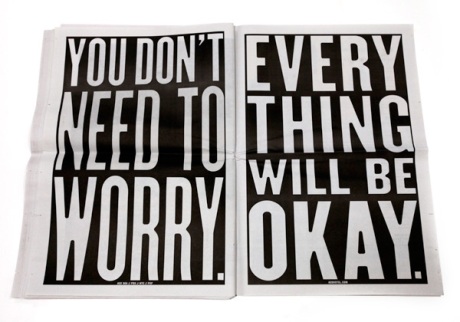
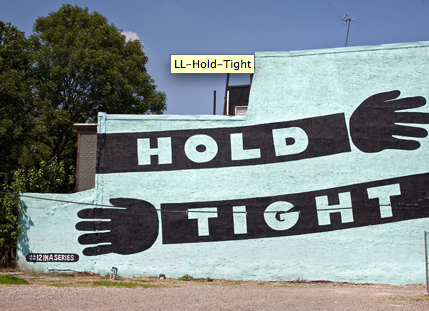 Espo does it right. This makes me feel. A Love Letter For You.
Espo does it right. This makes me feel. A Love Letter For You.
“I think it was Katherine McCoy who said that graphic design can never rise above its content. If I have nothing to say, the best design won’t help me.”
THIS PLACE PROJECTS PRESENTS : HOMETOWN LECTURE SERIES
October 29, 2009
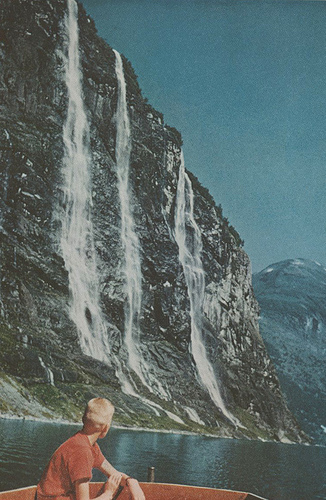
I made this due for myself tomorrow. It’s harder to hate deadlines when you make them yourself. This is a plan for the This Place event that I’d like to have. What follows is the information, copy, and visual inspiration for the Hometown Lecture Series.
HOMETOWN LECTURE SERIES
Volume 1
Tagline: “We all come from somewhere.”
Copy: This Place Projects invites you to talk about what you know best: where you come from. Come give a five-minute presentation on your city of origin, your rural locale, or the international array of places you’ve called home.
Bring one image or object to share.
Location: MK Gallery
Date/Time: Wednesday, November 18, 12 noon to 2pm
Aesthetic direction for HOMETOWN LECTURE SERIES: faded photograph, vintage, place, street, landscape, etc. colors faded to appear old, maybe just an old photograph. map, washed out, polaroid or other similar edges of photo.
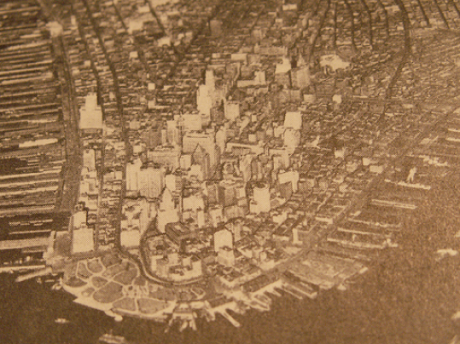
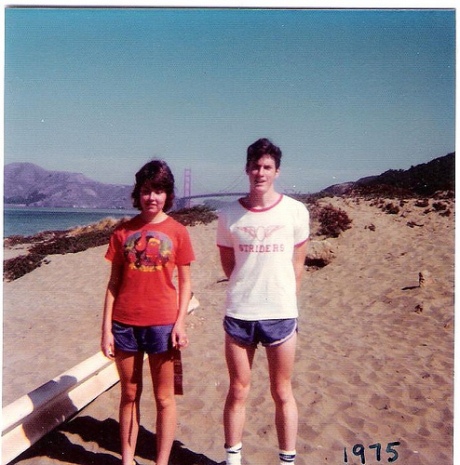
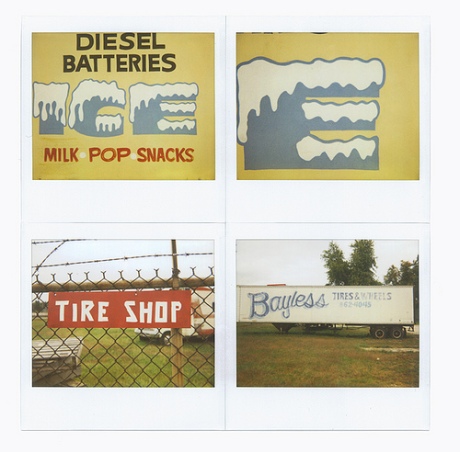
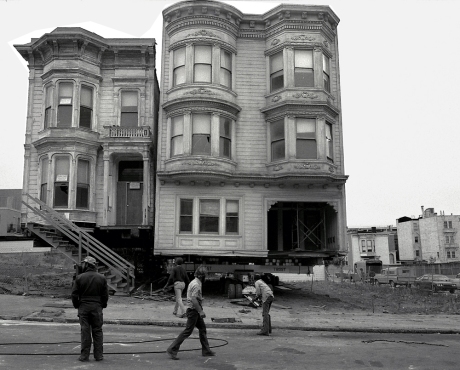

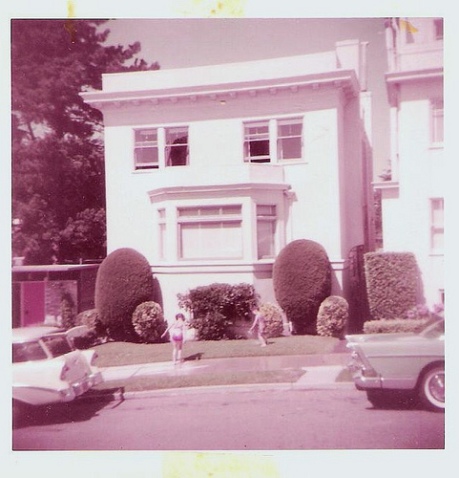
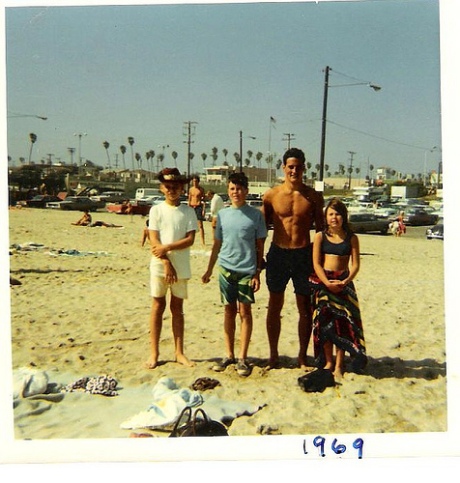
WORDPRESS THEMES
October 27, 2009
I definitely didn’t find exactly what I wanted to find, but there are WordPress themes out there that almost fit my high expectations! Here are a few that I’m considering. These were all found on Best WordPress Themes. Many are considered “magazine” style themes. I think I might need to take Art 342.
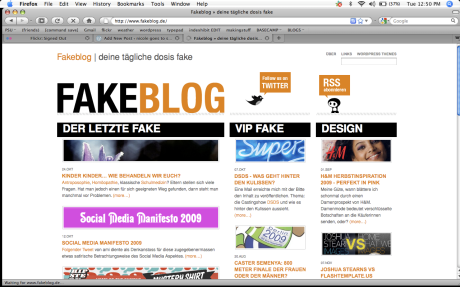 Top of the list. Would have to kill the orange if possible. Allows for categories.
Top of the list. Would have to kill the orange if possible. Allows for categories.
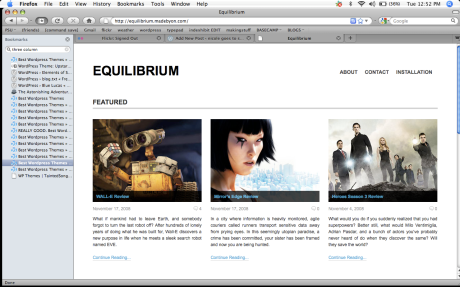 Another top contender. I like that it allows the images to be the main content, but there might be some trouble with navigation and people wanting to zip through posts like a regular blog.
Another top contender. I like that it allows the images to be the main content, but there might be some trouble with navigation and people wanting to zip through posts like a regular blog.
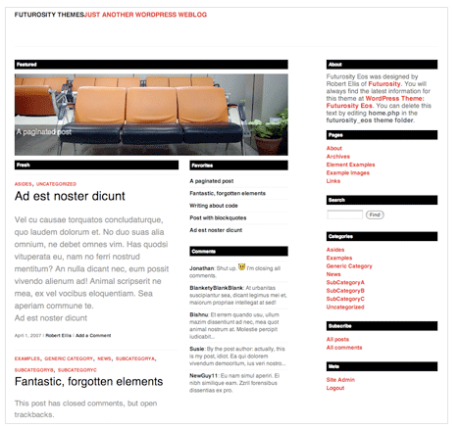 This is closest to what I had in mind, though it might be frustrating to have a whole column of navigation that I don’t have control over. (far right) I like that this has a place for a featured image. Futurosity Eos.
This is closest to what I had in mind, though it might be frustrating to have a whole column of navigation that I don’t have control over. (far right) I like that this has a place for a featured image. Futurosity Eos.

